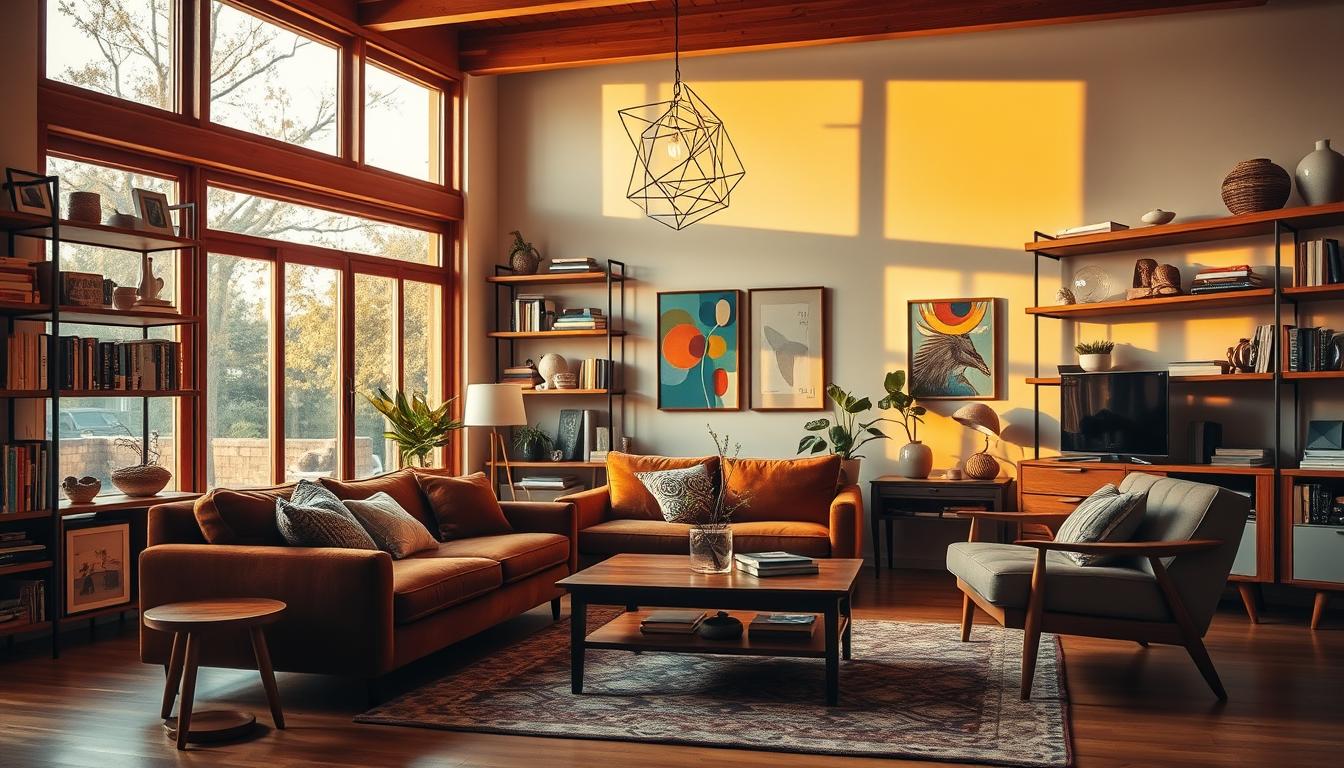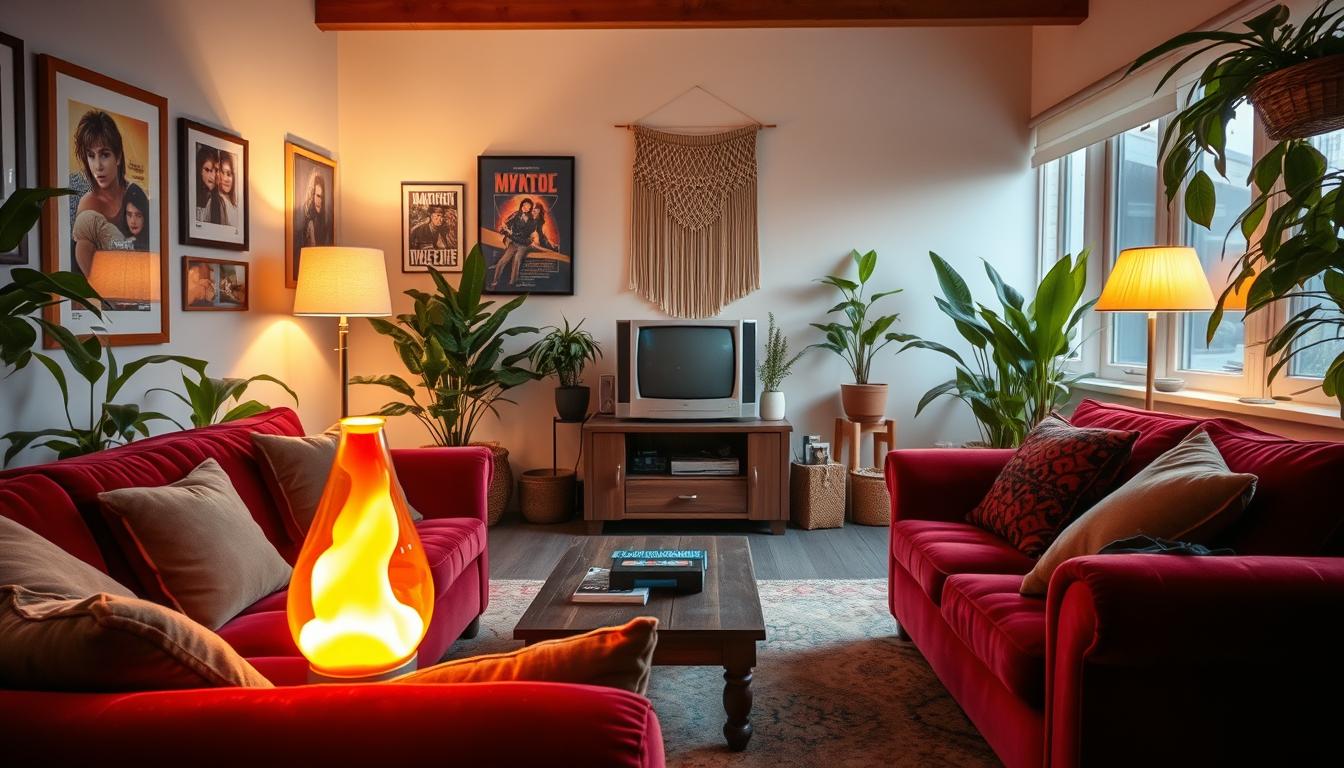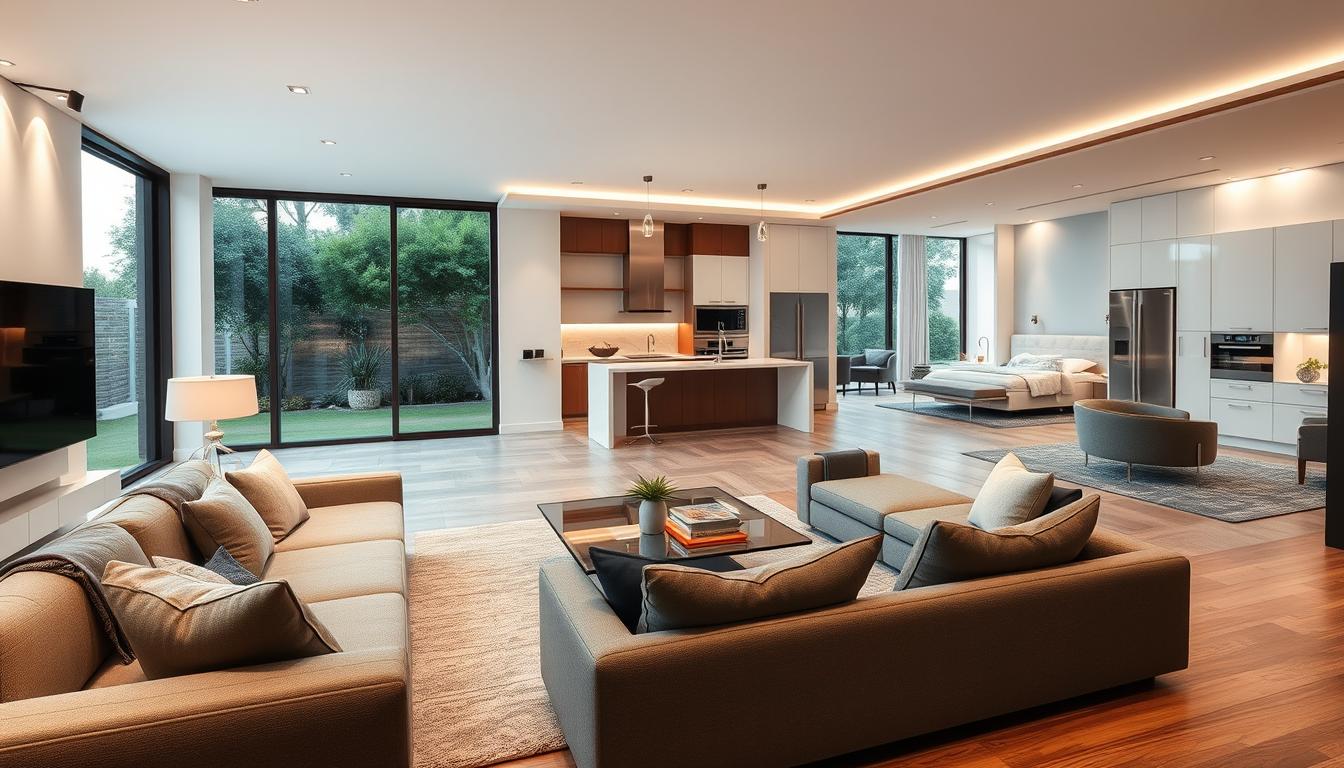The mid century modern style is big in today’s decor. It focuses on being useful, simple, and blending with nature. Did you know this style started in the 1930s and grew until the 1960s? It’s seen a big comeback in the last ten years.
Mid century modern decor is known for its clean lines, organic shapes, and simple look. It makes any room feel calm and elegant. As we look into mid century homes interior, we’ll cover what makes this style special. We’ll also give you ideas for making your home both beautiful and practical.
Key Takeaways
- Understanding the core principles of mid century modern style
- Identifying key elements that define mid century homes interior
- Learning how to incorporate mid century modern decor into your living space
- Discovering the importance of functionality and simplicity in mid century design
- Exploring ways to integrate nature into your mid century home
1. Understanding Mid Century Design Principles
Mid century modern interiors are more than a trend; they’re a timeless look. This style combines retro charm with modern practicality. It has won over many homeowners and designers.
The Essence of Mid Century Style
The heart of mid century style is about clean lines, organic shapes, and minimal ornamentation. It started in the mid-20th century. It values simplicity and function, making spaces feel open and flowing.
This design movement aims to merge indoor and outdoor areas. It’s inspired by mid century architecture. Big windows, sliding doors, and mirrors help blend the indoors with the outdoors, creating a smooth transition.
Key Characteristics of Mid Century Homes
Mid century homes use natural materials like wood and stone, alongside modern ones like steel and glass. The interiors often feature iconic furniture pieces from famous designers. This adds to the style’s unique appeal.
- Open floor plans that promote a sense of spaciousness
- An emphasis on horizontal lines, echoing the landscape
- Integration with nature through large windows and outdoor spaces
- A minimalist approach to decoration, focusing on functional pieces
By grasping these principles, homeowners can bring mid century modern style into their homes. They can create a retro interior that’s both stylish and practical.
2. Choosing the Right Color Palette
A good color palette is key to capturing mid century modern style in your home. This style blends earthy tones with bold brights and soft pastels.
Choosing colors for your mid century modern home is important. It involves using natural hues like walnut brown, olive green, and sky blue. You also need bold colors like orange and turquoise.
Popular Colors in Mid Century Interiors
Mid century modern design loves a mix of colors. It reflects the era’s love for nature and modernity. Iconic colors include:
- Earth tones like brown, beige, and taupe
- Nature-inspired hues such as olive green and sky blue
- Bold accent colors like burnt orange and turquoise
- Muted pastels, which add a touch of softness
These colors can be mixed in many ways. For example, combining earthy tones with bold brights creates a striking contrast. Mixing muted pastels with natural hues makes a soothing palette.
Tips for Combining Colors Effectively
It’s important to mix colors well for a harmonious mid century modern look. Here are some tips:
| Color Combination | Effect |
|---|---|
| Earth tones with bold brights | Creates a striking contrast |
| Muted pastels with natural hues | Produces a soothing palette |
| Monochromatic neutrals | Offers a clean and minimalist look |
Also, think about how vintage home furnishings can influence your color choices. These pieces can add unique colors and textures to your palette.
By knowing the mid century modern colors and how to mix them, you can create a palette that honors the style. It also shows your personal taste.
3. Furniture Selection for Mid Century Interiors
To get a true mid century modern look, picking the right furniture is key. This style is all about clean lines, organic shapes, and being functional. We should look for furniture that shows these qualities.
Iconic Furniture Pieces and Brands
Some furniture and brands are known for mid century modern design. Designers like Charles and Ray Eames, and Isamu Noguchi, made famous pieces. Their work showed the era’s style and pushed furniture design forward.
Some top mid century modern furniture pieces include:
- The Eames Lounge Chair, known for its comfort and sleek design.
- Noguchi’s Coffee Table, which combines simplicity with elegance.
- The Wassily Chair by Marcel Breuer, an example of innovative use of materials.
| Furniture Piece | Designer | Characteristics |
|---|---|---|
| Eames Lounge Chair | Charles and Ray Eames | Comfortable, sleek, molded plywood |
| Noguchi Coffee Table | Isamu Noguchi | Simple, elegant, glass and wood construction |
| Wassily Chair | Marcel Breuer | Innovative, tubular steel frame, leather straps |
How to Incorporate Modernist Furniture
Adding modernist furniture to your mid century modern home needs thought. Start with a few key pieces that show the mid century modern look. It’s also key to mix these with simpler items to keep the space balanced.
For more ideas on mid century modern interiors, check out our guide on designing mid century modern home interiors.
By choosing and placing furniture wisely, we can make a mid century modern interior that’s both stylish and useful. Whether we’re starting fresh or updating, staying true to mid century modern design is the goal.
4. Essential Textures and Materials
To create a true mid century modern look, understanding textures and materials is key. This style uses natural materials and new textures, showing the era’s atomic age design. It’s all about blending old and new.
Natural Materials Used in Mid Century Homes
Mid century modern design loves natural materials like wood, stone, and leather. These add warmth and realness to a room. Wooden furniture, like walnut or teak, was common in these homes.
Stone fireplaces or floors added class. These materials connect us to nature and show off the era’s skill. The feel of smooth wood and rough stone makes mid century homes special.
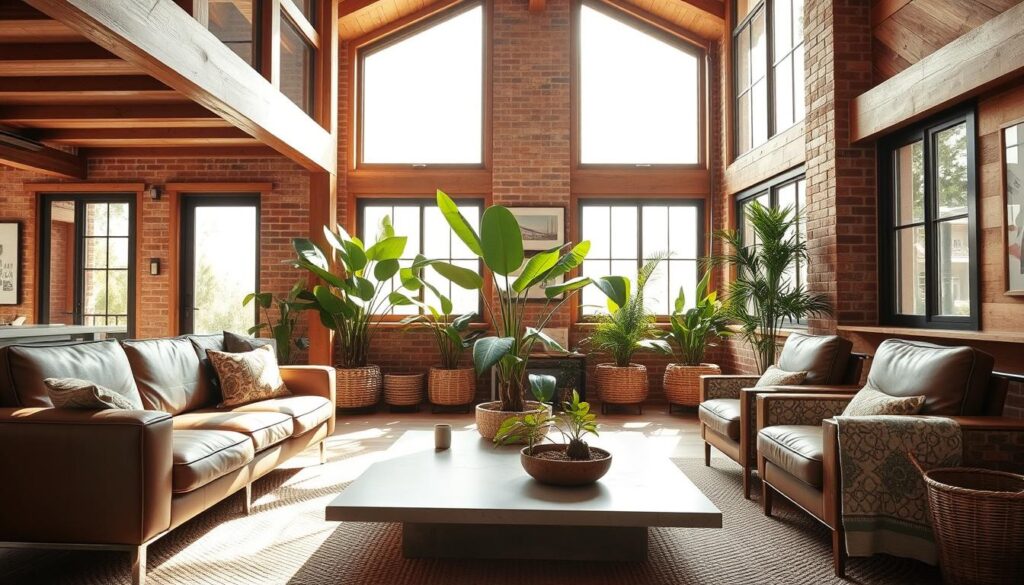
Balancing Textures for Visual Interest
It’s important to mix textures for a mid century modern look. Combining smooth and rough textures adds depth. For example, a smooth leather sofa with a wooden coffee table is interesting.
| Texture | Examples | Effect |
|---|---|---|
| Smooth | Leather, polished wood, glass | Sleek, sophisticated |
| Rough | Natural stone, reclaimed wood, woven fibers | Rugged, organic |
| Soft | Textiles, rugs, throw blankets | Cozy, inviting |
By mixing these textures, you can make a room that looks great and feels right. It captures the essence of mid century modern design.
5. Lighting Techniques in Mid Century Design
The right lighting is key in mid century modern design. It’s both practical and stylish. In these homes, lighting is not just for seeing; it’s also a big part of the look and feel.
To get the warm, inviting feel of mid century modern, knowing about lighting is important. We’ll look at famous lighting pieces and how to use them to make a space feel right.
Iconic Lighting Fixtures to Consider
Mid century modern design loves lighting that looks good and works well. Some top picks include:
- Sputnik chandeliers, known for their starburst-like design.
- Globe pendant lights, which add a touch of elegance and simplicity.
- Arc floor lamps, providing both task lighting and a stylish silhouette.
These lights do more than just light up a room. They also make a big statement, becoming the room’s centerpiece.
Creating Ambient Lighting
Ambient lighting is key in mid century modern design. It makes a space feel welcoming and complete. To get it right, layer different light sources:
- Use ceiling fixtures for overall light.
- Table lamps and floor lamps add warmth and depth.
- Dimmers help change light levels for different times or activities.
By mixing these lights, you can make a space that feels lively and inviting. Good ambient lighting makes a room work better and look its best.
6. Floor Plans and Space Utilization
In mid century modern architecture, the floor plan is more than just a layout. It’s a tool for creating a harmonious living environment. Effective space utilization is key to achieving the signature feel of mid century modern homes. Here, functionality meets elegance.
Open Concept Living Spaces
One of the hallmarks of mid century modern design is the open concept living space. By minimizing walls and barriers, open concept layouts create a sense of expansiveness. This makes rooms feel larger and more connected.
- Benefits of Open Concept Living:
- Enhanced natural light distribution
- Increased social interaction
- Flexibility in furniture arrangement
To implement open concept living effectively, consider the following:
- Use area rugs and furniture placement to define different zones within the open space.
- Incorporate sliding glass doors or large windows to blur the lines between indoors and outdoors.
- Select a cohesive color palette to maintain visual harmony across the open area.
Creating Flow in Your Space
Creating a sense of flow is crucial in mid century modern homes. The goal is to guide the eye and movement smoothly through the space. This involves thoughtful consideration of traffic patterns and zoning.
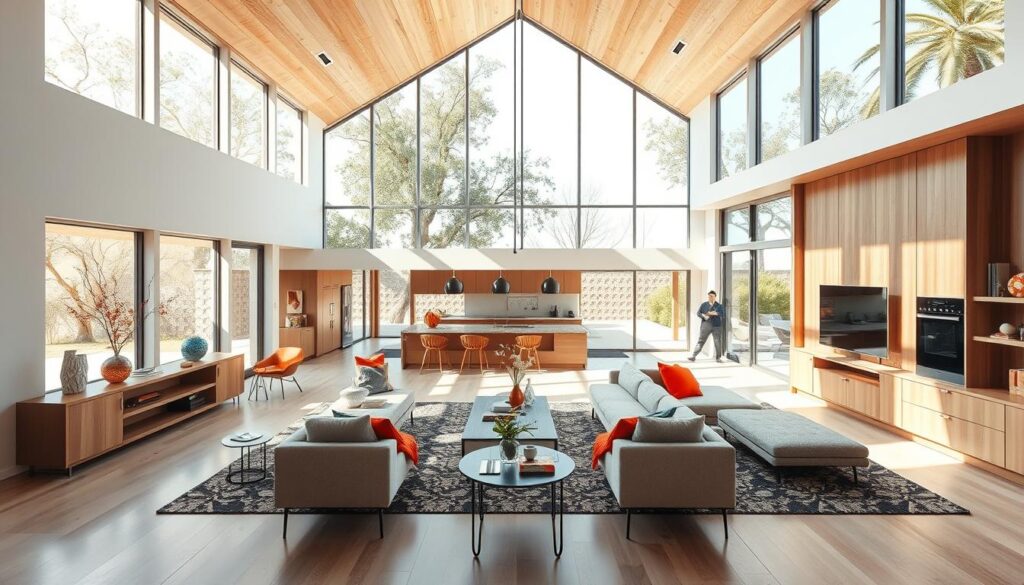
To achieve a smooth flow:
- Avoid cluttering pathways with too much furniture.
- Use furniture to create natural pathways and guide movement.
- Ensure that the layout promotes a logical progression from one area to another.
By focusing on open concept living and creating flow, homeowners can enjoy a mid century modern space. This space is both beautiful and functional.
7. Incorporating Art and Decor
To truly capture the essence of mid century modern style, it’s essential to thoughtfully incorporate art and decorative items. The right pieces can add personality and style to your space, making it feel more curated and complete.
Selecting Art Pieces
When it comes to choosing mid century art pieces, look for works that reflect the era’s emphasis on simplicity, organic forms, and abstract expressionism. Consider pieces by artists such as Joan Mitchell or Helen Frankenthaler, who were known for their contributions to the abstract expressionist movement.
Some key characteristics to look for in mid century art include:
- Bold color palettes
- Geometric and abstract forms
- A focus on texture and dimensionality
When selecting art, consider the scale of your walls and the color palette of your room. A large piece can be a statement, while smaller pieces can be grouped together to create a gallery wall.
Displaying Decorative Items
Displaying decorative items tastefully is crucial to avoiding clutter and maintaining the clean lines characteristic of mid century modern design. Start by selecting a few statement pieces, such as vintage decorative items or unique sculptures, and display them prominently.
For example, a vintage vase by Charles Hayward can add a touch of elegance to a coffee table or shelf. When arranging decorative items, consider the rule of thirds and balance:
| Item | Placement | Effect |
|---|---|---|
| Vase | Coffee Table | Creates a focal point |
| Sculpture | Shelf | Adds depth |
| Art Piece | Wall | Sets the tone for the room |
“The role of art is to make a space feel personal and reflective of the inhabitants’ tastes and experiences.” –
By thoughtfully incorporating art and decor, you can enhance the mid century modern aesthetic of your home, creating a space that is both stylish and meaningful.
8. Building a Connection with Nature
Mid century modern homes are known for blending indoor and outdoor spaces. This connection to nature brings harmony and tranquility to the home.
Indoor-Outdoor Flow
The idea of indoor-outdoor flow means moving easily from inside to outside. This is done with large sliding glass doors, big windows, and smart layout designs.
- Use large sliding glass doors to connect living areas directly to outdoor spaces.
- Incorporate expansive windows to bring in natural light and offer views of the outdoors.
- Design the layout to flow smoothly from indoors to outdoors, using similar flooring materials and color schemes.
Effective Use of Windows and Natural Light
Windows are key in mid century modern design. They light up the inside and show off the outdoors. Using windows and natural light makes a space feel bigger and more connected to nature.
Tips for maximizing natural light:
- Install skylights or larger windows to increase the amount of natural light entering the home.
- Use sheer curtains or blinds to control the amount of light and reduce glare.
- Place mirrors opposite windows to reflect natural light deeper into the room.
By focusing on indoor-outdoor flow and natural light, homeowners can make a mid century modern space. It feels big and connected to nature.
9. Modern Updates to Mid Century Homes
Updating a mid century modern home is a delicate task. It’s about keeping its original charm while adding modern touches. Homeowners often struggle to modernize their homes without losing the mid century modern style they love.
Integrating Contemporary Elements
To update a mid century modern home, start by adding modern touches that fit its design. This can include smart home systems or sustainable materials. For example, swap old lighting for energy-saving LED lights that still look good.
Updating furniture and decor is another way to refresh a mid century modern home. Choose modern pieces that match the style but use new materials and textures. A sleek sofa in a durable fabric can be a great addition to a living room.
| Contemporary Element | Mid Century Modern Feature | Integration Tip |
|---|---|---|
| Smart Home Technology | Original Wood Paneling | Install smart thermostats and lighting controls that complement the existing wood paneling. |
| Sustainable Materials | Iconic Furniture Pieces | Use reclaimed wood or low-VOC paints to update the home while preserving its iconic furniture. |
| Modern Lighting Fixtures | Large Windows | Install energy-efficient LED lighting that works in harmony with the home’s large windows. |
Maintaining Original Character While Updating
When updating a mid century modern home, keeping its original character is key. This means preserving its unique features like woodwork and floor plans. Instead of replacing these, restore or refurbish them.
Looking for inspiration? Check out how homes from the 1970s have been updated. https://homestylista.com/reviving-the-1970-home-interior-our-tips/ offers tips on keeping the original charm while making the space modern.
By carefully adding modern elements and keeping the original character, we can make our mid century modern home both modern and true to its roots.
10. Sustainable Practices in Mid Century Interiors
The mid century modern style loves natural materials and blending indoors with outdoors. This makes it great for eco-friendly design. It’s about cutting down on waste and making our homes healthier and more stunning.
Eco-Friendly Materials and Furnishings
Using eco-friendly materials and furniture is key in mid century modern design. Look for items made from recycled, recyclable, or sustainably sourced materials. For example, furniture made from reclaimed wood is not only stylish but also eco-friendly.
Choosing durable furniture is also important. It lasts longer, reduces waste, and fits the mid century modern values of simplicity and function. Find pieces that are both high-quality and timeless in style.
Energy-Efficient Solutions
Energy efficiency is vital in mid century modern homes. Use energy-saving appliances, smart home tech, and LED lights. These steps help cut down energy use and lower bills.
The focus on natural light in mid century design also helps save energy. Big windows and skylights let in more sunlight, reducing the need for artificial light.
Adding passive solar design to your home is another smart move. It involves smart window placement, insulation, and thermal mass to keep temperatures stable without using much energy.
11. Common Mistakes to Avoid
Designing a mid century modern interior can be exciting. But, it’s easy to make mistakes that ruin the look. Knowing these common errors helps you avoid clutter and create a stylish, functional space.
Overdecorating
One big mistake is overdecorating. Mid century modern design focuses on simplicity and function. Too many decorations can make a space look messy and lose its charm. Choose your decor wisely, making sure it adds value or interest.
Ignoring Functionality
Another mistake is forgetting about functionality. Mid century modern homes are meant to be both beautiful and practical. Think about how your furniture and decor will be used. This way, you ensure your space is not only lovely but also comfortable and useful.

